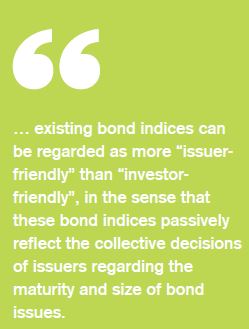
Bond Risk Premia: The New Frontier In Factor Investing and Smart Beta
Industry Analysis
Bond Risk Premia: The New Frontier In Factor Investing and Smart Beta
Frank Fabozzi
Lionel Martellini
Riccardo Rebonato
Bond Risk Premia: The New Frontier in Factor Investing and Smart Beta
The abundance of theoretical and empirical research on factor investing in the equity universe stands in sharp contrast to the relative scarcity of research about how to efficiently harvest risk premia in bond markets. That relatively little is known about the out-of-sample performance of factor-based bond portfolio optimisation models is perhaps surprising given the importance of fixed-income investments within the portfolios of institutional and private investors.
 From the investment practice standpoint, a similar contrast actually exists between factor investing in the equity space (which is a relatively mature subject) and factor investing in bond markets (which is still is in its infancy). It is indeed fair to say that the so-called smart beta approach is now firmly grounded in equity investment practices, and the key question for an increasing majority of institutional investors is not whether one should use smart beta, but rather which and how much smart beta to use. In parallel, interest in smart beta equity products is rapidly growing in retail and private wealth management. In contrast, the concept of smart beta in the fixed-income space is still relatively less mature, despite the obvious importance and relevance of the subject.
From the investment practice standpoint, a similar contrast actually exists between factor investing in the equity space (which is a relatively mature subject) and factor investing in bond markets (which is still is in its infancy). It is indeed fair to say that the so-called smart beta approach is now firmly grounded in equity investment practices, and the key question for an increasing majority of institutional investors is not whether one should use smart beta, but rather which and how much smart beta to use. In parallel, interest in smart beta equity products is rapidly growing in retail and private wealth management. In contrast, the concept of smart beta in the fixed-income space is still relatively less mature, despite the obvious importance and relevance of the subject.
One first possible explanation behind the scarcity of the research on risk premia harvesting in bond markets and related investable solutions is that bonds are often held as part of investors' hedging portfolios, where the focus is on matching interest rate risk factor exposures on the asset side to interest rate risk factor exposures on the liability side, as opposed to risk/reward ratio maximisation. This is, however, not a sufficient reason for ignoring the need to generate attractive risk-adjusted performance. After all, there are infinitely many bond portfolios with a given target duration, and selecting the one with the highest risk-adjusted performance should intuitively improve investor welfare.
Another possible explanation is that bond portfolio construction models pose a number of technical and implementation challenges that do not exist in the equity universe. In particular, individual bonds, unlike stocks or constant maturity bond indices, have a finite maturity, which imposes a very specific structure on the covariance matrix and expected return vector. Moreover, no-arbitrage relationships exist between bonds of various maturities and these relationships impose a set of constraints on risk/return and factor exposure parameter estimators, for which there is no equivalent in equity portfolios.
Additional implementation hurdles include the lack of reliable market prices for bonds that typically trade in thin markets and the concern over high implementation costs.
In what follows, we provide a brief review of the theoretical, empirical and practical challenges related to factor investing in the fixed-income space. The modern approach to factor investing actually suggests that we should first identify robust and economically-motivated sources of risk in fixed-income markets, select securities on the basis of the desired factor tilts, and then apply an efficient weighting scheme aiming to enforce the highest level of diversification to eliminate as much unrewarded risk as possible from investor portfolios. In this context, our ambition is to discuss each one of these aspects, with applicability to various segments of fixed-income markets, most importantly sovereign and corporate bond markets.[1]
Limits of Traditional Bond Benchmarks
Over recent years, a number of concerns have been expressed about the (ir)relevance of existing forms of corporate and sovereign bond indices offered by index providers, many of which are simply not investable in the first place. Beyond the lack of investability, there are two major problems with existing bond benchmarks, namely (1) an excessive concentration and lack of proper diversification and (2) a lack of stability and control over the underlying set of factor exposures.
Lack of Diversification in Sovereign and Corporate Bond Indices
Lack of diversification is the first major problem with bond indices that simply weight the debt issues by their market value. Given the large share of the total debt market accounted for by issuers with large amounts of outstanding debt, market-value-weighted corporate bond indices will have a tendency to overweight bonds with large amounts of outstanding debt. This weighting scheme will inevitably lead to excessive concentration and lack of diversification. The issuer concentration in government-bond indices is very undesirable from the perspective of the construction of a well-diversified portfolio: Staal et al. (2015), for instance, document that 55% of the Barclays Treasury Index (which is supposed to refer to 38 different countries) is made up of US and Japanese bonds, and that the same two bonds account for over 65% of the total risk of the index.
While the claim that over-represented issuers may give rise to adverse selection and poor diversification is compelling, simplistic rules to correct for issue size are likely to be ineffective, since it is not size in itself that is ‘dangerous’, but size relative to ability to repay and to refinance debt (see the next section for a more detailed discussion of fundamentally-weighted indices). So, for example, a correction of the market-capitalisation benchmarking rule based on the naive comparison of the size of debt outstanding for US Treasuries or Greek government debt would do little to rebalance an over-representation of supposedly riskier bonds; nor would looking at the amount of debt outstanding as a fraction of GDP do much to redress re-financing risk in the case of the government debt of Italy and Japan, two markets which are predominantly financed by foreign and domestic investors, respectively.
 Moreover, it is often argued that such indices not only give too much weight to some assets but also that they give too much weight to riskier assets, a problem that has been dubbed the “bums' problem” (Siegel, 2003). This concern may be particularly relevant in the corporate bond market if, during periods of sector-specific speculative bubbles, some industry sectors (such as tech stocks in the run-up to 2001 or financial stocks in the run-up to 2006) found it ‘excessively’ easy to issue cheap debt, thereby becoming over-represented in a market-capitalisation benchmark.
Moreover, it is often argued that such indices not only give too much weight to some assets but also that they give too much weight to riskier assets, a problem that has been dubbed the “bums' problem” (Siegel, 2003). This concern may be particularly relevant in the corporate bond market if, during periods of sector-specific speculative bubbles, some industry sectors (such as tech stocks in the run-up to 2001 or financial stocks in the run-up to 2006) found it ‘excessively’ easy to issue cheap debt, thereby becoming over-represented in a market-capitalisation benchmark.
While it is actually debatable whether debt weighting really leads to the most risky securities being over-weighted[2], it is clear that market-value debt-weighted indices leads to concentrated portfolios that are in opposition with investors' needs for efficient risk premia harvesting, which involves holding well-diversified portfolios. In a nutshell, a good case can be made that existing bond indices tend to be poorly diversified portfolios, regardless of whether or not the over-weighting applies to the wrong constituents.
Lack of Stability and Control in Factor Exposures
In addition to the problem of concentration, fluctuations in risks' exposure (such as duration or credit risk in existing indices) are another source of concern − see Campani and Goltz (2011) for more detail. Such uncontrolled time variation in risk exposures is incompatible with the requirements of investors that these risk exposures be relatively stable so that allocation decisions are not compromised by implicit choices made by an unstable index. For example, an asset-liability mismatch would be generated by changes in the duration of the bond index if the latter were used as a benchmark for a pension fund bond portfolio.
 More generally, it appears that existing bond indices can be regarded as more "issuer-friendly" than "investor-friendly", in the sense that these bond indices passively reflect the collective decisions of issuers regarding the maturity and size of bond issues. Bond issuers make a decision on the duration of the bonds that they issue, the decision being based on minimising funding costs for the issuer. When investors make duration decisions, they are based on optimising an investor's investment objectives. There is no reason to believe that there will be any consistency between the cost minimisation objective of issuers and the investment optimisation objective of investors in the determination of market duration. As a result, the duration that is obtained from an index can be considered as a "historical accident" (Siegel, 2003).
More generally, it appears that existing bond indices can be regarded as more "issuer-friendly" than "investor-friendly", in the sense that these bond indices passively reflect the collective decisions of issuers regarding the maturity and size of bond issues. Bond issuers make a decision on the duration of the bonds that they issue, the decision being based on minimising funding costs for the issuer. When investors make duration decisions, they are based on optimising an investor's investment objectives. There is no reason to believe that there will be any consistency between the cost minimisation objective of issuers and the investment optimisation objective of investors in the determination of market duration. As a result, the duration that is obtained from an index can be considered as a "historical accident" (Siegel, 2003).
As is the case for equity indices, the lack of diversification of unrewarded specific risk exposures, and the lack of explicit control over systematic rewarded risk exposures, are two distinct major flaws in bond indices if they are to be used as benchmarks for investors' portfolios. A number of index providers or asset managers have launched new forms of smart beta bond portfolio indices to try to address some of the challenges with traditional weighting schemes based on the market value of debt.
Review of First Generation Smart Beta Initiatives in Bond Markets
Here, we provide a broad overview of first generation initiatives, which can be broadly classified in two different categories that have historically focused on fixing the concentration problem – fundamental approaches and diversification approaches. We then move on to an analysis of more recent factor-based approaches, which focus on stability in factor exposure problem.
Fundamental indexing in the bond market is a direct transfer of methodologies originally developed for equities. In the methodology used in Arnott et al. (2010) for corporate bond indices, the following five factors are used to assign a score to each (investment grade and high yield) corporate bond: book value of assets, total dividends, total cash flow, sales and face value of the debt issue. First, weights are computed for each corporation and with respect to each factor, by using the trailing five-year average of each of the above metrics over the aggregate five-year average across all corporations. While it might seem unclear why it would be desirable to use a 5-year trailing value as opposed to the current value for the fundamentals, one practical advantage of this procedure is that the implied smoothing leads to a reduction in turnover. Then, the composite measure is obtained by equally weighting four of the measures: assets, dividends, cash flow and sales.
For emerging market sovereign bonds, the approach developed by Arnott et al. (2010) is based on the following factors: total population, square root of land area (as a crude approximation for resources), total gross domestic product, energy consumption and face value of the debt issue. Similarly to the case of corporate bonds, weights are first computed for each country and with respect to each factor, by using smoothed five-year averages of the above-mentioned metrics over the aggregate metric across all countries. Then, a country's aggregate weight is the equally-weighted average of its score on the individual factors.
The fundamental approach for constructing a bond index raises several concerns. First, the methodology used does not address the concern over the stability of factor exposure. Moreover, the problem of concentration is approached with a purely ad-hoc methodology, and better-diversified portfolios could be constructed on the basis of standard risk models. More importantly, it is unclear why some backward-looking trailing average of some arbitrarily selected variables should contain more useful information than say bond ratings, which for all their flaws are based on a much richer information set.
By contrast, the diversification approaches rely on risk and/or return parameter estimates as well as risk-based portfolio optimisation models to design well-diversified bond portfolios. These include minimum concentration (MC) portfolios (which correspond to the closest approximation of an equally-weighted strategy subject to constraints such as duration or weight constraints), global minimum variance (GMV) portfolios and diversified risk parity (DRP) portfolios, also known as factor risk parity portfolios.
One may also use expected return estimates based on economically motivated priors for Sharpe ratio maximisation exercises as in Deguest et al. (2013).
 This article is one of many articles in Investment Management Review (IMR) special edition Autumn 2017 which covers important recent insights into the asset management industry. To access the full edition please click on http://www.imrmagazine.com/edhec-special-edition.php.
This article is one of many articles in Investment Management Review (IMR) special edition Autumn 2017 which covers important recent insights into the asset management industry. To access the full edition please click on http://www.imrmagazine.com/edhec-special-edition.php.
[1] In principle, some of the insights discussed in this paper can also be of relevance to other fixed-income markets such as MBS markets, swap markets, etc.
[2] A higher weight for an issuer with a high market value of debt does not necessarily mean that the index is over-weighting issuers with a high face value of debt. An issuer with a high amount of par value debt outstanding will only get a high weight if the market value is relatively close to par value, which implies that the issuer is not perceived to be very risky. It is therefore not clear why the market value-weighted index should become riskier. In addition, loading onto riskier issuers should not necessarily be a problem if this risk is rewarded by higher expected returns.
References
- Arnott, R., J. Hsu, L. Feifei and S. Shane. 2010. Valuation Indifferent Weighting for Bonds. The Journal of Portfolio Management 36(3).
- Campani, C. and F. Goltz. 2011. A Review of Corporate Bond Indices: Construction Principles, Return Heterogeneity, and Fluctuations in Risk Exposures. EDHEC-Risk Institute Publication.
- Deguest, R., F. Fabozzi, L. Martellini and V. Milhau. 2013. Bond Portfolio Optimisation in the Presence of Duration Constraint. EDHEC-Risk Institute Publication.
- Siegel, L. 2003. Benchmarks and Investment Management. The Research Foundation of the Association for Investment Management and Research. Charlottesville, Virginia.
- Staal, L., M. Corsi, S. Shores and C. Woida. 2015. A Factor Approach to Smart Beta Development in Smart Beta. Journal of Index Investing 6(1).

